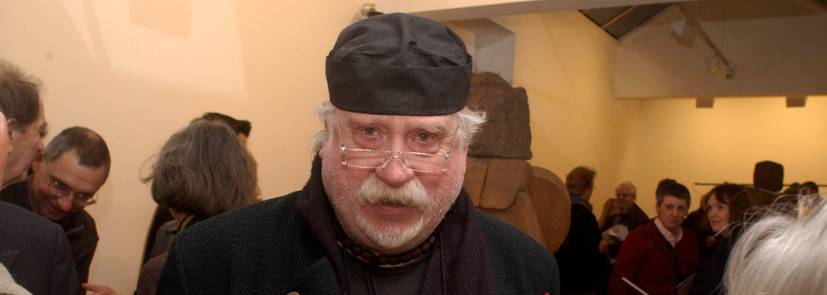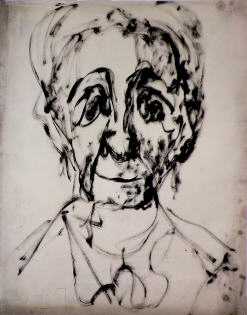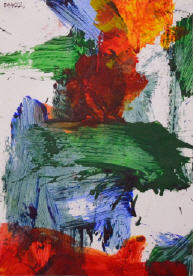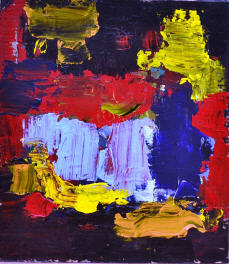
Donnagh at an Anthony Caro exhibition in 2003
(c) Dafydd Jones, www.dafjones.com.
Donnagh McKenna (1936 – 2011)
Donnagh McKenna was born to Irish parents on the 7th January 1936 in Manchester. He studied from 1956 at the Manchester College of Arts, at the Extra-Mural Department of Manchester University and, later, at the Slade School of Fine Arts in London. He taught in London’s art schools from 1962 to 1970.
 During his lifetime he produced over 1,100 paintings until his death in London on the 16th August 2011.
During his lifetime he produced over 1,100 paintings until his death in London on the 16th August 2011.
In 1956 he started with naturalistic figure drawings and caricatures but soon went on to paint portraits in subtle grey tones in oil on canvas.
He made his first abstract charcoal drawings in 1958 and slowly he left figurative designs behind to concentrate on abstracts. His first colour compositions appeared from 1961.
An art review by Cissie Lodge for an exhibition at the Warwick Arts Trust in Pimlico, London in 1986, classifies him as “one of a group of painters who have developed abstract expressionist work in this country, especially over the last five years. McKenna’s work has a powerful immediacy and visual impact. But the apparent ease and effortless spontaneity of his paintings has very definite firm roots and discipline.”
When Cissie Lodge met Donnagh he was very conscious of the living history of his art, as established in Britain since the 1930s by Ben Nicholson, Barbara Hepworth, Henry Moore, Naum Gabo, and even Oskar Kokoschka, who was working temporarily in the country. “We haven’t got the pressure of the pioneers. We can do it without worrying about whether or not abstract art is acceptable”, he stressed in an interview.
 Meanwhile Donnagh had become opposed to figurative images. “Figurative art is visual fiction. It requires you to believe an illusion, to believe that things are something other than they are; what you are really looking at is paint on canvas. Abstract art is a visual fact because what it creates and produces is the product of paint on canvas.”
Meanwhile Donnagh had become opposed to figurative images. “Figurative art is visual fiction. It requires you to believe an illusion, to believe that things are something other than they are; what you are really looking at is paint on canvas. Abstract art is a visual fact because what it creates and produces is the product of paint on canvas.”
He based his work on the ‘orthodox’ abstract expressionist ideas of Hans Hofmann (1880 – 1966) the ‘push-pull’ theory, which constantly seeks to exclude the illusion of space on the surface of the painting. The composition of the painting counteracts the tendency of colours to produce the illusion of space.
The intention, therefore, is to start and finish with a flat surface, to keep colours under control and forbid them to recede or dominate. ‘Paintings are objects and not pictures of things. They are expressions of feelings – like music. It needs a trained eye to accept abstract paintings.’
“People are looking for recognition of something they already know. They are embarrassed by what they do not understand, and they say they don’t like it. When they say ‘I know what I like’ they actually mean they like what they know, and for ‘know’ read ‘recognise’.”
 Donnagh McKenna rejected the idea that only the elite can understand abstract painting. He said if people would just look at a work of art, not just glance at it, but stand and look at it, then they would begin to appreciate its quality. It requires time, study and appreciation. “If you cannot give such things, you cannot expect art to leap off the wall and grab you”, he insisted.
Donnagh McKenna rejected the idea that only the elite can understand abstract painting. He said if people would just look at a work of art, not just glance at it, but stand and look at it, then they would begin to appreciate its quality. It requires time, study and appreciation. “If you cannot give such things, you cannot expect art to leap off the wall and grab you”, he insisted.
His paintings were produced as the result of experience, not the other way round. It may be a recent or a childhood experience, or an experience with another painting. But that idea has to be broken down and reconstructed in terms of the logic of the painting, so that the original idea is both held onto and recreated.
This is why the thick or thin working of paint on the surface exists simultaneously with a feeling of the unexpected, the mysterious with a familiar memory – creating a poetic ambiguity. This ability to retain the original sensation prevents his work from turning into a pedestrian assertion of “the facts” or academic formalism.
McKenna’s work shows the vitality and power of the abstract in paintings – alive into the future.
